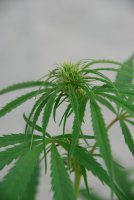Excellent thread Big Sur! Made me sign up to 420 mag just to follow it. The notes from your collection read like a field guide for herbal enthusiasts on a landrace trek. Only thing missing are the illustrations .... I like your book idea. Something like this for the growers.... The Complete Cannabis Cultivator
.... I like your book idea. Something like this for the growers.... The Complete Cannabis Cultivator
I'm glad to your hear your Durban X-Fire has that morning electricity. It's hard for me to be productive smoking anything that drags me down too much. I'll save that heavy herb for when I'm in my PJs.
Talking about botanical hybrids. In the palm world, I've heard that the female imparts the majority of traits. It always makes me wonder when making cannabis crosses if the female has more influence. DJ Short dives into this in his book. I know that the latest PuntoRojo x MangoBiche cross I made has a mango aroma to it, so the male did have an effect on the flavor profile.
What is your experience with bud structure on the mexicans vs the colombians? In my limited contemporary experience the lumbos have large calyces (bracts?) and the mexicans have really farking tiny bracts and longer pistils too. I'm smoking some good friend's acapulco gold and the aroma is fantastic sweet clean limonene with no dankness. The '73 guerrero x blueberry I tried from last year is very pungent in an expanding herbal, pinesol way. Maybe it's the mint you talk about with Mexicans.
 .... I like your book idea. Something like this for the growers.... The Complete Cannabis Cultivator
.... I like your book idea. Something like this for the growers.... The Complete Cannabis CultivatorI'm glad to your hear your Durban X-Fire has that morning electricity. It's hard for me to be productive smoking anything that drags me down too much. I'll save that heavy herb for when I'm in my PJs.
Talking about botanical hybrids. In the palm world, I've heard that the female imparts the majority of traits. It always makes me wonder when making cannabis crosses if the female has more influence. DJ Short dives into this in his book. I know that the latest PuntoRojo x MangoBiche cross I made has a mango aroma to it, so the male did have an effect on the flavor profile.
What is your experience with bud structure on the mexicans vs the colombians? In my limited contemporary experience the lumbos have large calyces (bracts?) and the mexicans have really farking tiny bracts and longer pistils too. I'm smoking some good friend's acapulco gold and the aroma is fantastic sweet clean limonene with no dankness. The '73 guerrero x blueberry I tried from last year is very pungent in an expanding herbal, pinesol way. Maybe it's the mint you talk about with Mexicans.






